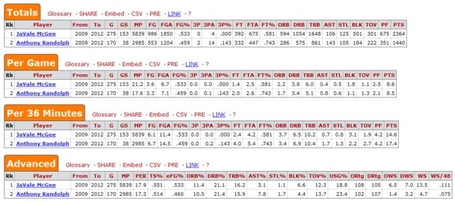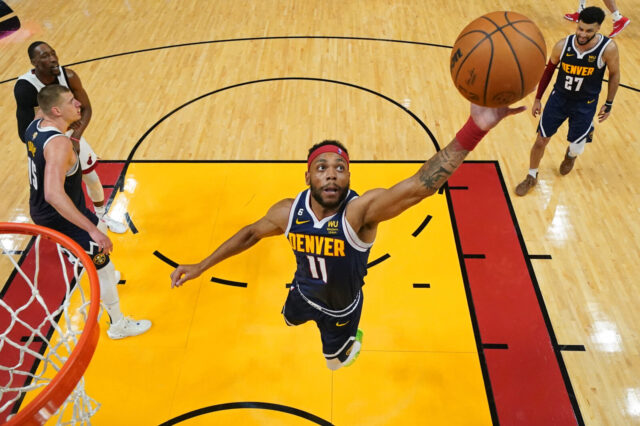What to make of Anthony Randolph?
Nobody has figured that question out. Anthony Randolph seems to have all the physical tools to succeed in the NBA, but in four years he hasn’t ever played more than 23 minutes per game. Chris Andersen is gone, and the Nuggets believe that they can get, at minimum, a similar level of performance from Randolph – energy, rebounding, and a little scoring. He’s capable of equal parts brilliance and knucklehead, traits the Nuggets seem to constantly find in their roster – and we all witnessed the startling turnaround in JaVale McGee’s game since joining the Nuggets.
Can we expect to see the same sort of growth and maturity from Randolph?
When the Nuggets recently signed Randolph to a small 3-year $6 million contract, the thinking was that the team needed a capable big man that could fill Chris Andersen’s empty nest roles of shot blocking, rebounding, and providing a burst of energy from the 4/5 position. At just 23 years-old (especially when compared against the now relatively ancient 34 year-old Andersen), Randolph seems ready to contribute in these areas immediately.
First, I feel like the best way to think of Randolph is as a slightly smaller McGee. They have very similar body types – long armed, rangy, and slight for their size. Randolph’s wingspan of 7’3″ is just barely less than McGee’s absurd 7’6″. Randolph beats out McGee by about three inches in vertical jumping ability (35″ to 32.5″) – which is sort of incredible, when you think about it – but has a shorter standing reach. They both suffer when attempting to defend in the post against a bigger body in the form of an Andrew Bynum, Omer Asik or Nikola Pekovic, but their length intimidates many smaller players into altering their shots or deferring to their teammates. Sufficed to say, their physical characteristics are very comparable.
Despite playing almost half as many minutes as JaVale McGee (and on three different teams as opposed to two), Randolph puts up numbers that are very close to his front court counterpart:
(Click for big)
Points Per Game: Randolph 8.5 (McGee 8.6)
Rebounds Per Game: 5.1 (6.0)
Blocks Per Game: 1.1 (1.8)
Fouls Per Game: 2.1 (2.5)
PER (Player Efficiency Rating): 17.3 (17.9)
Randolph is slightly more turnover prone, but also had a much higher USG% (percentage of team possessions used) at 23.4% compared to McGee's 18.8%. This suggests that again, like McGee, Randolph should be utilized as an off-the-ball asset putting back misses, grabbing rebounds, and generally not attempting to create his own shot. One area where Randolph shines that McGee does not, interestingly, is free throw shooting – Randolph hits a respectable 74.3% from the charity stripe, compared to the "close your eyes and hope for the best" 58.1% of McGee. McGee's poor free throw shooting becomes a liability late in games, and Randolph may get some additional late-game looks because of it.
On offense, both players are at their best when they’re cutting to the basket and getting out on the break. Their length and athleticism allow them to play above the rim and force the issue with shotblockers. If Randolph and McGee see the floor together, it’s a potential matchup nightmare for teams attempting to match their leaping abilities. Alongside Kenneth Faried and JaVale McGee (to say nothing of Jordan Hamilton and Wilson Chandler), Andre Miller and Ty Lawson are going to have no shortage of lob targets when they’re running the floor.
However, one area that you don't want to see Randolph raising up is … well … anywhere that's not "directly at the rim". Last season, he shot an ugly 32.7% (35-107) between 3-feet and 23-feet from the basket. I'd post a shot chart, but it's probably better for us not to look too closely. Those are Corey Brewer-esque levels of poor shooting, and I sincerely hope Randolph understands that the Nuggets want him at the rim and not taking wing jumpers. Randolph's left-handed game provides an interesting asset to his play in the paint, however, as many players are very used to hedging left to force a player to their non-dominant left hand. If other teams don't realize Randolph is comfortable driving and using his left, they could be in for some nasty poster dunks from baseline drives.
Defensively, Randolph needs to utilize his quickness and length to "bother" just like Bird used to. He won't be capable of playing too physically in the post given his frame, but his shotblocking ability is going to be a big factor and influence a lot of attempts in the paint. I do worry that his low basketball IQ is going to become a problem, though. The Nuggets' defensive scheme – please, hold your laughter – is predicated on switching and using quickness and athletic ability to cover up mismatches created by pick and rolls and back screens. Randolph is going to need to increase his on-court awareness during defensive sets if he hopes to see truly significant playing time.
In all, I think the Randolph signing was an excellent pickup for this Nuggets team. Denver fans knew that the writing was on the wall with Andersen, and picking up a player 11 years younger with physical tools comparable to McGee's for just $2 million per season is an absolute steal.
In a lineup featuring Ty Lawson, Arron Afflalo, Danilo Gallinari, Randolph, and McGee, the Nuggets will have a superb mix of speed, outside shooting, rebounding, shotblocking and athleticism. The length of that lineup will force many teams into bricked outside jumpers, which are just going to ignite the fast-break. Randolph still has a lot to prove to show that he deserves minutes in an already stacked rotation, but I think that the abilities that he brings to the table are going to get him some playing time.
I'll leave you with a few highlights of Randolph's favorite activity (dunking) that we'll see a lot of this coming season. Enjoy!
Randolph with the dunk of the night off a nice pick and roll to the rim:
Dunking over Yao (twice) – notice he also gets a T from Joey Crawford:
Catching a nice lob from Rubio:



